The humble AA has been powering millions of devices for many decades (and when inebriated with alkaline, leaking and leading many to their graves…)
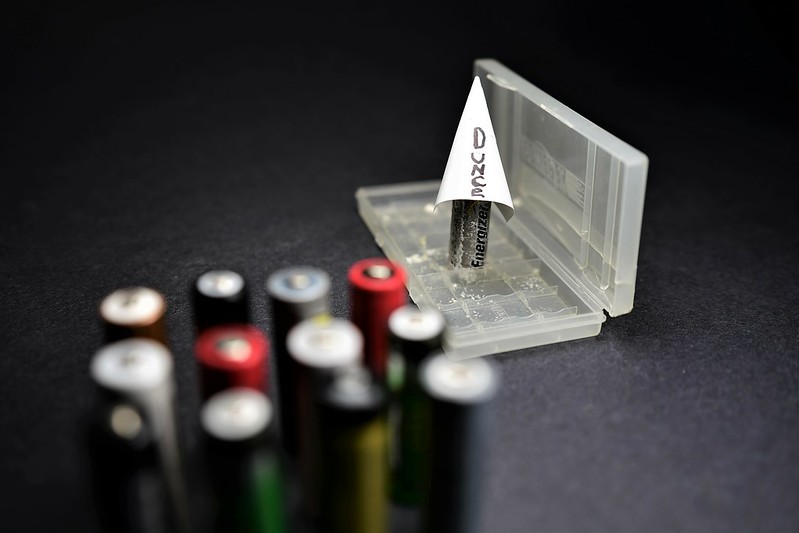
(need I say more? :P)
Regardless of the chemistry it comes in, it is the most commonly used battery size overall. However, in the flashaholic world, it takes a backseat to the venerable 18650’s as it simply can’t match its energy density or high current capability. For example, it takes four Eneloop Pro’s to match the energy of a single 18650 3400 mAh cell but it’d take up nearly double the volume (~123k mm3 vs. ~66k mm3). Regardless, the AA still serves a very important segment of the market for non-flashaholics. Case in point, the majority of lights that adorn the shelves of your local mass retailer are predominantly powered by AA’s since the typical user would rarely know (much less care) what emitter is installed and what battery types to use for their lights. It's for these users that I'd typically recommend AA-based lights paired with Eneloop’s as it's far less fickle and much safer than dealing with Li-Ion cells. For those looking for higher output, I'd guide them to one of the multi-cell AA lights in which case, there’s a newcomer in Manker's MK41:

There are two different emitters available; either XHP 35 HI or HD and while it runs on 4 x AA's, it's the first to my knowledge that can also run on 4 x 14500's. This gives it a nice bump in output and throw but let's see how else it distinguishes itself from its peers...
PACKAGING & ACCESSORIES
The MK41 comes in the typical plain cardboard box with an outer sleeve that features a picture, manufacturer & model name and company info on the back:
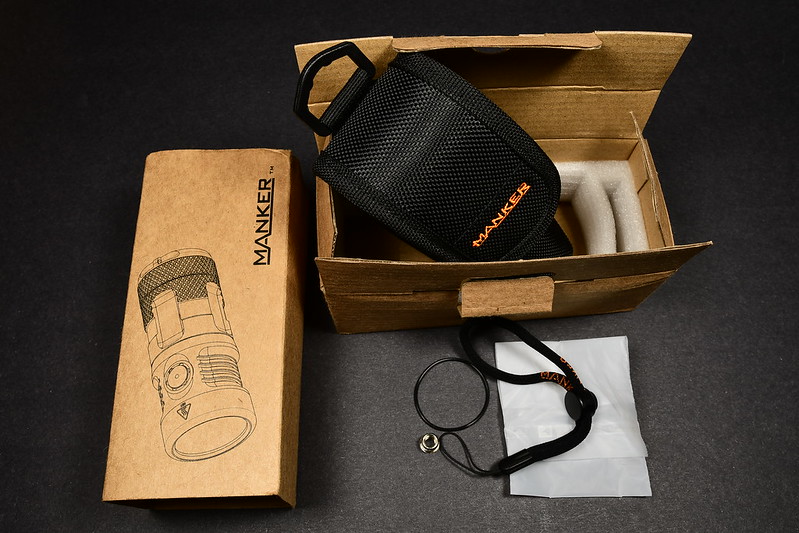
There’s less foam than usual since a nice holster is included along with a tripod mount bolt, 1 x o-ring, wrist strap and though mine didn’t come with it, I’d imagine the instructions/specs sheet.
MFG SPECS
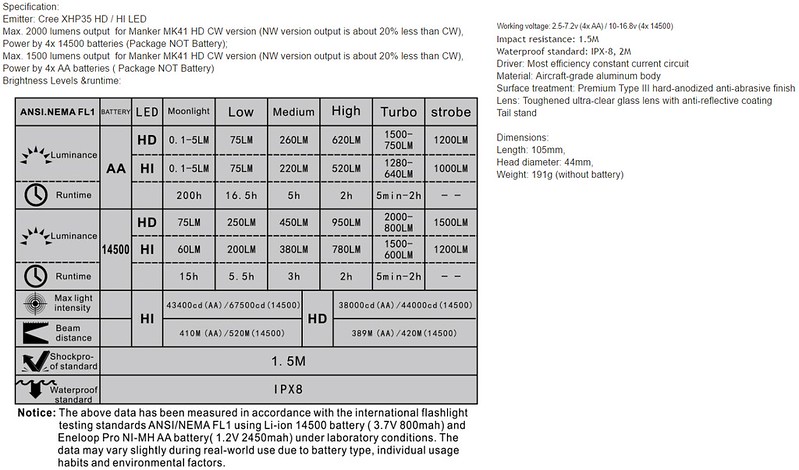
VID REVIEW
Here's also an in-depth vid review which covers outdoors beamshots, comparos vs. other 4 x AA lights (older gen's), runtime & output & throw measurements:
www.youtube.com/embed/CBJcZKNcbKE
DESIGN & FEATURES
Style-wise, the MK41 is essentially a U11 that has been shortened and fattened to accommodate 4 x AA cells:
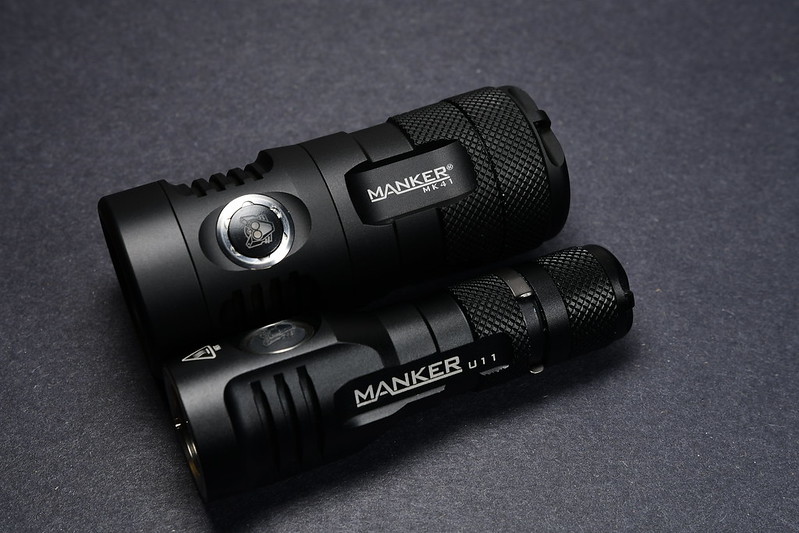
Starting at the head, there is a removable bezel (43.8mm ⌀) that holds down the double-sided AR coated lens (strangely, the Hot symbol isn’t on the HD version):

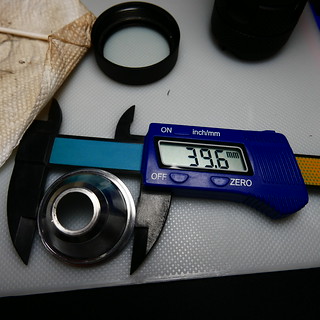
Once removed, you get an unimpeded view of the XHP35 HI/HD and the black plastic centering disc for the reflector.
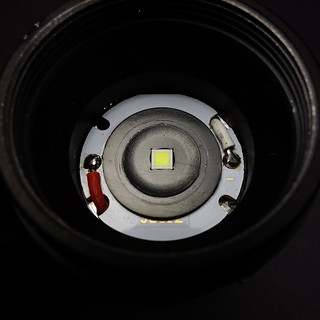
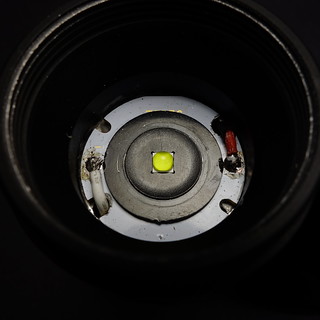
The reflector is actually screwed onto the threads inside of the head:
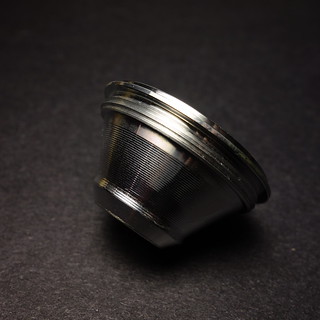
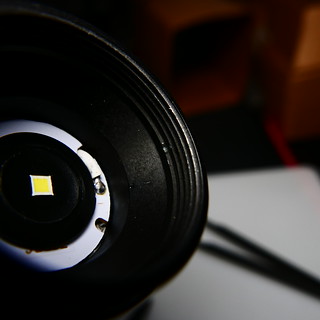

This is required since only a light spread of thermal grease and not glue is used under the PCB (shows Manker understands that “less is more” here) so it’s the pressure of the reflector against the PCB board that ensures good thermal conductivity with the shelf that it sits on. I was encouraged to see the use of silicone wires instead of the more typical PVC ones. One must use due caution when threading the reflector back on as there is some play to assist with centering. Use of a tacky surface (preferably a flat piece of leather or rubber) would greatly aid in getting a good fit (you’ll really need to be careful not to touch the reflector).
An electronic side-switch has become nearly ubiquitous throughout their lineup and it is again adorned with the Quinlan logo which is semi-transparent for the pair of LED’s behind it to convey the Dragon breath function as well as battery indicator (Blue = >75% | Purple = ~50% | Red = <20%):


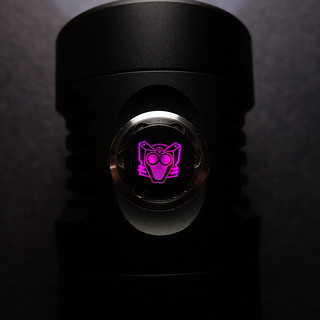

There are heat fins that grace either side of the switch but during my testing, the MK41 doesn’t get all that hot with the HI version reaching around 92F and the HD at 102F during runtime testing on Turbo (with small fan blowing weak breeze):
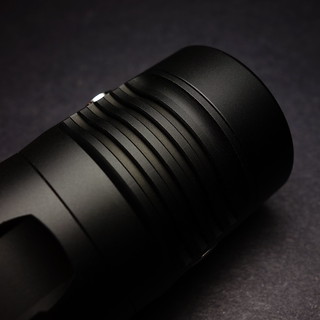
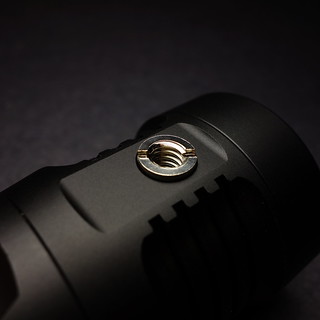
On the opposite side of the switch is a threaded hole for the tripod mount that didn’t come pre-installed. Unlike the MK35, it doesn’t mount flush and sticks out a mm or so.
Not sure if this was intentional but its use however increases the versatility of the MK41 especially with a diffuser in place, it can be a great primary or supplementary lighting as I had highlighted in my MK35 review (more so the HD than the HI due to the higher output and broader hotspot):

Case in point, it offers a very nice primary lighting for close up shots that matches well w/the beam color of other cool white LED's.
Both my review samples’ heads are glued to the body (I’m unsure if production versions will be as well). Just aft of the head is the tube which features four oblong grooves of which two bear the Mfg/Model and the other with various symbols:

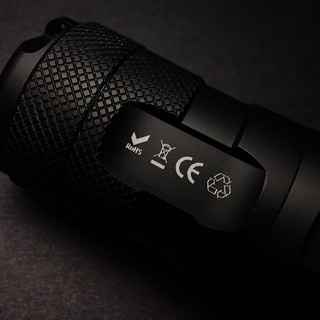
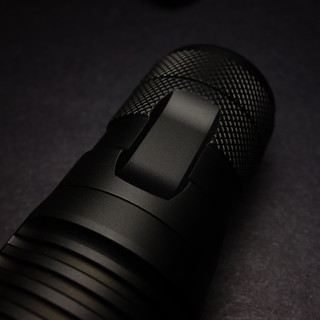
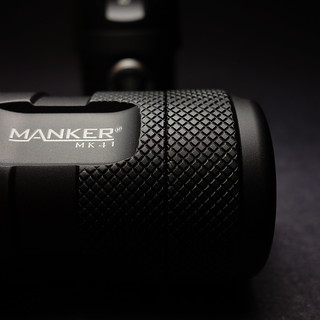
The texture towards the end of the tube and around the tailcap is relatively mild but does aid with grip during use.
The base of the tailcap is flat allowing for stable tail-standing use and there is an attachment point for the included wrist strap that is nicely rounded off so as not to gouge anything:
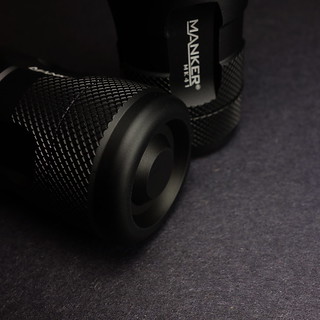
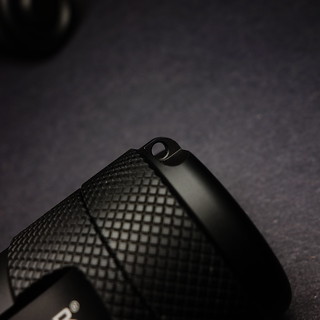
The MK41 employs the same battery arrangement as the MK35 by routing the four cells in series without a battery carrier. The tailcap has a rotating PCB with two springs on it for the cathodes and two anode buttons (also repeated on the head side PCB) thus flat top cells can be used:
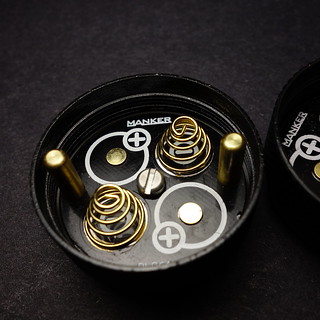
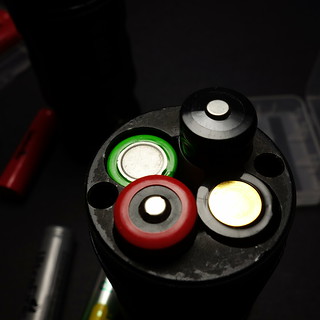
This allows for a good variety of different sized cells albeit with limitations; the longest cell it can accommodate and still be able to fully close the tailcap is about ~50.3mm. While you can technically use slightly longer ones, you won't be able to completely screw in the tailcap and it'll expose the o-ring. Additionally, you may risk damaging the cells by over-tightening it to get it to close that gap:
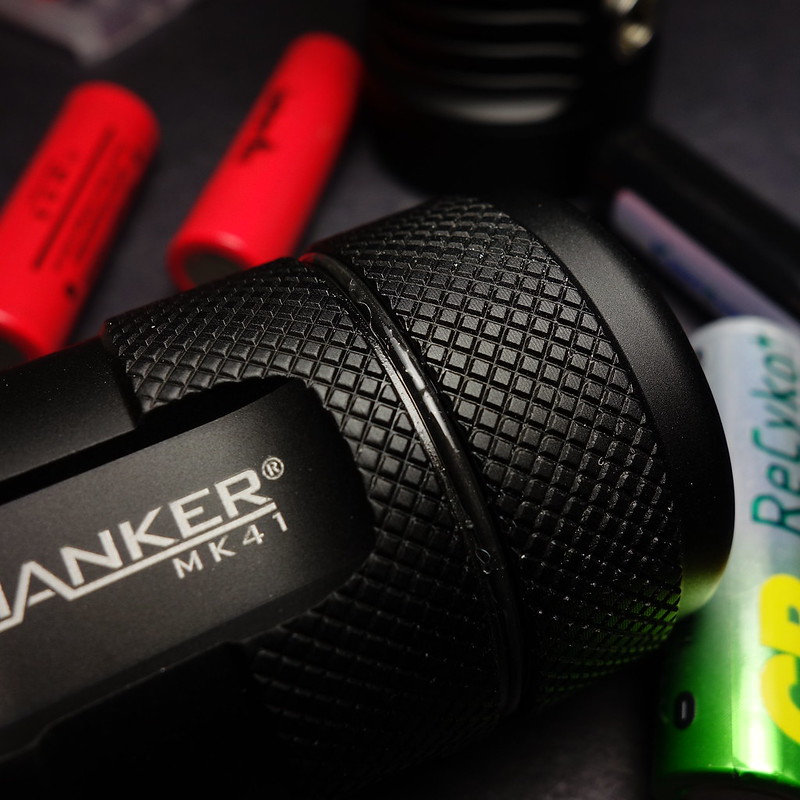
I don't have any protected cells this short so have been using IMR's when I'm not running them on NiMh's.
SIZE & HANDLING
As compared to the other 4 x AA lights in my collection, it’s the shortest albeit not the smallest diameter-wise, that distinction goes to the D40A (TN36 UT thrown in for comparative purposes):
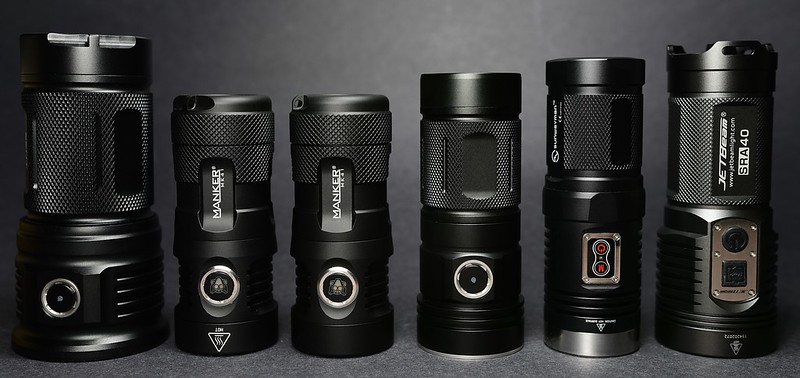

L to R: ThruNite TN36 UT | Manker MK41 HI | Manker MK41 HD | ThruNite TN4A | Sunwayman D40A | Jetbeam SRA40
Though it’s a pop can style light, the diameter isn’t unwieldly in my medium-size hands, and I don’t have any issues using the light in an overhand or underhand grip:
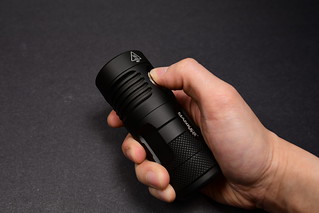

However, the switch is uncharacteristically stiff and this is the first Manker light that I find a little difficult to operate (especially when trying to do quick successive presses). This can be a good thing if you don’t really ever want to access the blinky’s, engineering mode or the electronic lock out feature; it also greatly mitigates accidental activation. I personally do prefer the use of said modes thus I’d prefer slightly less resistance to activate. It however does provide good tactile feedback during use, invoking solid clicks.
UI AND OUTPUT LEVELS
The MK41’s UI is nearly identical to that of the MK35, it just has one less output level:
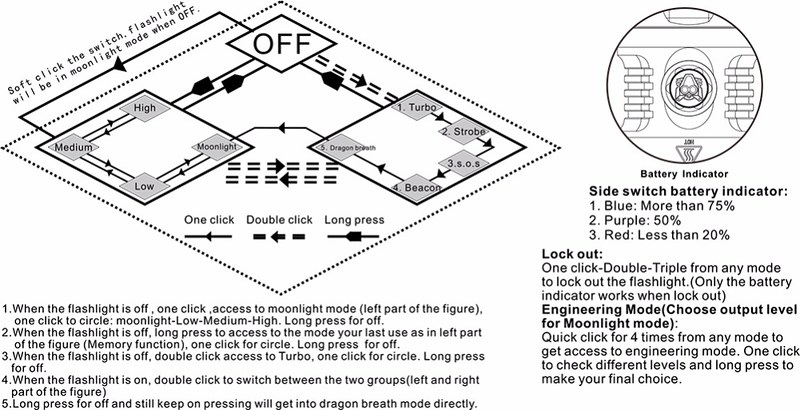
There are basically two Groups which we’ll dub the left diamond Group 1 (output levels) and the other Group 2 (Turbo, blinky’s & Dragon breath flash):
For Group 1, there are 4 fixed output levels (non-programmable) of which any can be memorized as the last-used mode. Sequence = Moonlight > Low > Med > High > Med > Low > Moonlight, etc. etc.
For Group 2 (of which none can be memorized). Sequence = Turbo > Strobe > S.O.S. > Beacon > Dragon Breath flash > [will then cycle through Group 1 output levels starting in Moonlight]
From off:
• a quick click will always turn on the MK41 to Moonlight*, subsequent quick clicks will cycle through the output levels in sequential order from Low through High but in a deviation from the majority of UI’s that will then cycle back immediately to the lowest output after High, the MK41 will instead go back down in output sequentially (High > Med > Low, etc.). A long click (~.5 sec) in any output level will shut off the MK41 and memorize the last used output level*.
• a long click (~.5 sec) will always turn on the MK41 to the memorized output level, subsequent quick clicks will cycle through the output levels in sequential order to the next higher level even if you were in the descending phase of output levels when you memorized the last used mode. For example, let’s say you were last cycling downwards from High > Med and then long clicked to memorize that mode, when you long click to turn back on the MK41, it’ll turn on in Med and a short click will cycle it back up to High. A long click (~.5 sec) in any output level will shut off the MK41 and memorize the last used output level*.
• a quick double-click will access Turbo mode and each subsequent click will cycle it through the other Group 2 modes and then back to the Group 1 output levels after the Dragon Breath (beginning with Moonlight). A long click (~.5 sec) in any Group 2 mode will shut off the MK41 without memorization invoked.
When On:
• in any Group 1 output level - a quick click will cycle the light to the next higher/lower output level (depending if you were on the ascending or descending output phase); a long click (~.5 sec) will shut off the MK41 and memorize the last used output level*
• a quick double-click will immediately enter Group 2 modes starting with Strobe mode and each subsequent quick click will cycle through the other blinky modes as well as the Dragon Breath after which it'll go back to the Group 1 output levels beginning with Moonlight; a long click (~.5 sec) will shut off the MK41 and memorize the last used output level* unless it was in a Group 2 mode
*Moonlight is never memorized since it’s always readily available with a quick click, this makes perfect sense since it won’t override the other memorized output levels in case you long-click to shut off from Moonlight mode.
Electronic lock-out feature:
With the MK41 on or off, press in successive short clicks (with a very brief pause in between the sets of clicks):
one short click [brief pause] two short clicks [brief pause] three short clicks
The MK41 will then be in lock-out mode and the breath flash will turn on until the lock-out is disengaged. To exit lock-out, follow the same procedure as to engage it and then it will turn back on to the last memorized output level. This is a little tricky and make take some time to master and the stiffer side-switch vs. the MK35 makes it a little challenging to nail down. I cover this in my vid here.
Hidden Engineering Modes:
The MK41 allows both the Moonlight and Turbo output levels to be reprogrammed within a certain range to better suit one's personal preference. The lowest output of the Moonlight is so low as to be unmeasurable on my PVC LMD and could be considered a Firefly though it’s even lower than most; the only other light I know that’s capable of such a low mode is Sunwayman’s V11R, though in real-word usage, it’s unusable.
Moonlight Engineering mode^: with the MK41 on, quickly press the switch four times and then it’ll enter the programming mode at the last memorized level. There are a total of 20 levels that one can cycle through that I measured as follows:
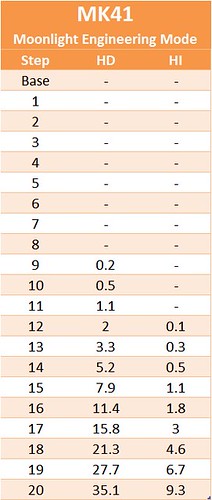
Once at the desired level, long press the switch to shut off the MK41 and the new Moonlight level will be memorized.
To enter the Turbo Engineering mode^: remove the tailcap to power off the MK41, then while holding the side switch, screw on the tailcap until the light turns on. This will engage the Turbo engineering mode starting at the base level of which each quick click will cycle through another 10 levels (for a total of 11) to cycle through:

Note: measurements are approximate since Turbo mode is non-regulated
There are subtle differences in output between the steps so you’d really need to look carefully but the jump between Max back to Min (on the 11th click) should be obvious. Once you’ve reached the desired output level, unscrew the tailcap to memorize it.
^Will not work with Li-Ion cells, furthermore, I didn’t notice any changes to the Moonlight or Turbo levels when using Li-Ion cells after reprogramming.
Here’s a dedicated video covering this:
www.youtube.com/embed/voUu8TKg41k
FIT & FINISH
Both samples are early test samples (I’m not aware of any difference with Production versions though…) yet they still exhibit the solid builds of other Manker lights. As mentioned in my previous reviews, I feel that they’ve firmly nailed down the machining aspects so it’s really the electrical aspects that I’ll be covering here. I was encouraged to see that premium flexible silicon wire was used rather than the more typical PVC wire and more importantly, the thermal paste wasn’t excessive and oozing out in gobs from underneath the MCPCB (as covered in Design & Features section).
I received the HI version first and noticed like with the MK35 that the tailcap PCB wasn't greased but the HD version did have it (if perhaps in excess, but I'll take that over bone dry):

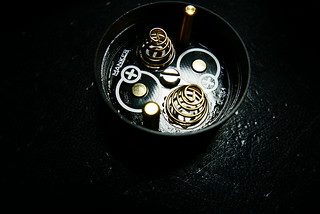
I noticed that on the HD version (was shipped after HI), they've further protected the positive feed with heat shrink tubing between the PCB:
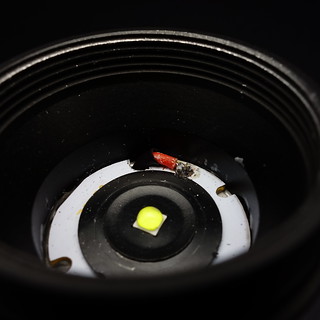

I also like the fact that the holster, which feels pretty sturdy, covers pretty much the entire light thus offering good protection.
I measured standby drain as follows:
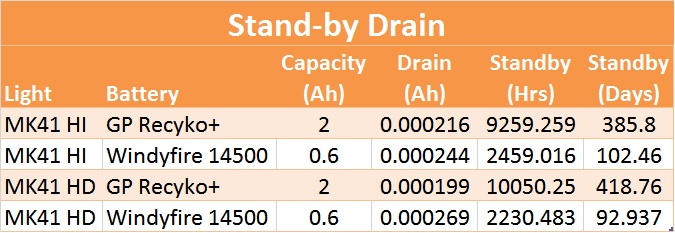
This is outstanding and is so trivial as to not merit concerns with leaving Eneloops (or equivalents) in the MK41 long term. It’s still excellent for 14500’s but due to the substantially lower capacity of these cells, I’d exercise a little caution.
*leaves cell’s self-discharge out of the calculation so anticipate slightly lower
My main nitpick would be the stiff sideswitch as I can see it potentially being difficult to operate for those who haven’t trained their thumbs by button mashing during marathon gaming sessions or those with any hand/wrist ailments. It may actually work out well for those considering the MK41 but wouldn’t use the extra modes, however, it can stand to be just a little softer and I’ve conveyed this feedback to Manker. Perhaps it’ll soften a little with use over time or as the weather warms up. Aside from this, I didn’t identify any other glaring faults.
THROW SUMMARY

The throw & output differences between the MK41 HI and HD provide a good example of what happens when an emitter is de-domed (I do question whether they use identical drivers since the behavior at end of run was different - see Runtime section for details). The HI version clearly is the better thrower of the two and is the best of the 4 x AA lights in my collection. It does however fall behind the HD in terms of output as expected but does top the older lights.
The Jetbeam SRA40 still competes well in throw owing to the larger diameter of the reflector that is also substantially deeper. Replace its XM-L2 emitter with an XHP35 HI and I’d feel pretty comfortable saying that it would beat the MK41 HI as you simply can’t overcome the basic law of physics as there is only so much you can do to drive an emitter efficiently.
Perhaps Manker intentionally pursued this small form factor but it’d be intriguing to see how the MK41HI would’ve fared with a slightly larger turbo head like on the Eagletac’s SX30A4 which measures ~.5” larger.
However, to put things in perspective, the MK41 HI offers nearly the same output as the U21 (more actually with 14500’s) and roughly 74% of the throw in a smaller form factor overall.
RUNTIME & OUTPUT ON MAX
- conducted as per ANSI FL1 standards with small USB fan blowing weak breeze
- in interests of time, only Turbo mode was tested
- lumens measured on my PVC LMD, I don't claim 100% accuracy but it should prove reasonably so relative to other lights I've measured over the years using this method
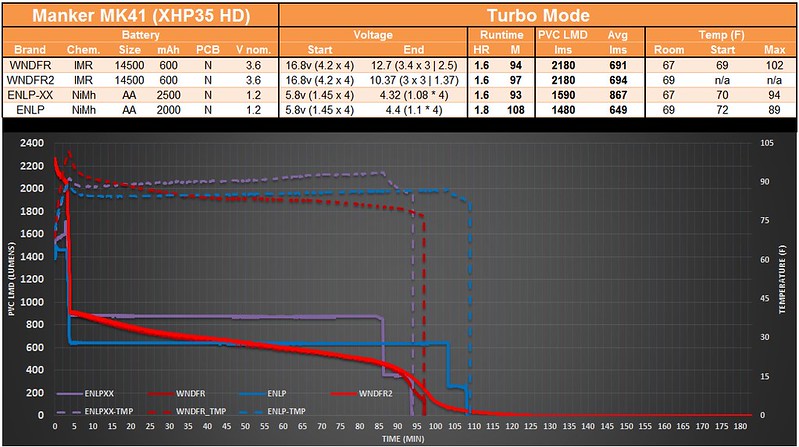
- as expected, the MK41 HD features higher output but less throw than the HI; output measured slightly exceeds Manker's output with NiMh or Li-Ion's (1590 & 2180 vs. 1500 & 2000 respectively)
- on NiMh, it features a weird slow ramp up during the phase before step down and will actually spike as high as 1700lms before stepping down ~5 minutes (most obvious with the purple run on Eneloop Pro's in chart above); unlike the HD though, the MK41 will abruptly shut off once cells are depleted so one needs to pay heed to the low voltage warning via the sideswitch that is given well in advance of this
- with Li-Ion's, the MK41 will happily continue to drain the cells as can be seen in the extended run (bright red line); unlike with the NiMh, there is no sudden cut off at the MK41 is running in moonlight mode at this point
- temperature reached was 102F max so moderately warm
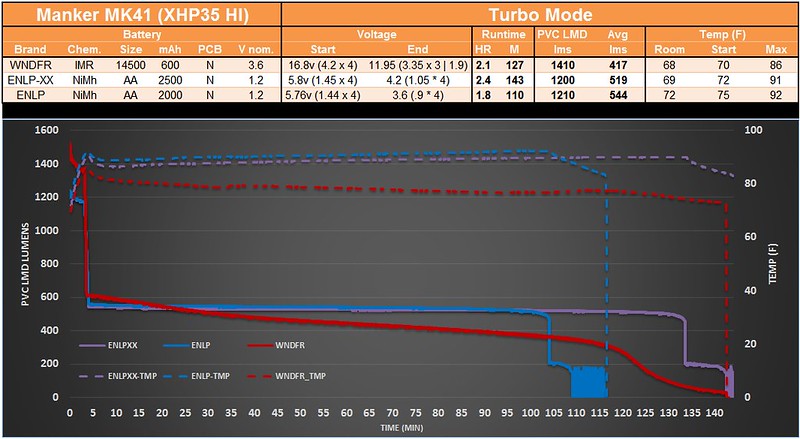
- output measured was slightly lower than Manker's output with NiMh or Li-Ion's (1200 & 1400 vs. 1280 & 1500 respectively); regardless of cell used, Turbo is not regulated with a steady decline until step down @ ~5 mins
- the H1 version features a low voltage warning that also flashes the emitter itself in addition to the side switch's warning so it's pretty much unusable at this point (this only happens with NiMh cells)
- as with the HD, on Li-Ion's it too will happily continue to drain the cells steadily; again, one needs to pay heed to the low voltage warning light and swap out the cells when it's invoked
- max temp reached as 92 so MK41 HI doesn't get meaningfully hot
INITIAL SUMMARY

I’ve made no secret my disdain for Alkaline cells despite depending on them heavily in my younger years but once I discovered rechargeable cells, with very few exceptions, I haven’t gone back. Thus it’s a delight for me to see the MK41 accepting Li-Ion’s thus offering more flexibility in terms of the batteries one can feed it. It’s a light that I can freely recommend to non-flashaholics to pair with Eneloops with the bonus that when they are ready, they can run it off Li-Ion’s. Even without the added bump in output/throw, the MK41 fairs competitively amongst the other 4 x AA lights in my collection. To be fair, it’s faced off with older gen lights but I will update the review or include the MK41 in future comparisons if I acquire newer lights of same form factor.
For now, here are my initial thoughts:
turboBB-licious
- ability to accept Li-Ion’s with bump in output/throw should satisfy flashaholics while being safe with Eneloops for regular folks
- hidden engineering mode for both Moonlight and Turbo’s grants additional flexibility to custom tailor lowest/highest output to one’s tastes
- with exception of perhaps some exposure of the bezel, included holster just about completely overs the entire MK41 protecting it nicely
- milled solid body doesn’t require need of a battery carrier (though I generally prefer them, I know most don’t)
- Group 2 modes hidden but easily accessed when desired
- competitive output/throw in consideration of its relatively compact form factor for a 4 x AA light
turboBB-cautious
- key sticking point remains that stiffer than normal side-switch which may hinder access to Group 2, lock out and engineering modes (but can be a plus if one never uses these)
- while standby drain is excellent when used with Eneloops, one would need to exercise caution with Li-Ion’s due to lower capacity of these cells
- wrist-strap a little tight
- lock-out feature a little tricky to invoke
- step down after 5 minutes
- given 4S1P config, care should be taken to use matched cells (especially with Li-Ion’s)
- on HD version, one needs to pay heed to the low voltage warning since light will suddenly cut out when batteries are sufficiently depleted
- for the OCD’s, tripod mount doesn’t sit flush once screwed in
turboBB-wishes
- though a trade off, perhaps lower the output and provide regulated runtime on Turbo with no step down
- a diffuser
=======
Disclosure: MK41 HI & HD provided by Manker for review.